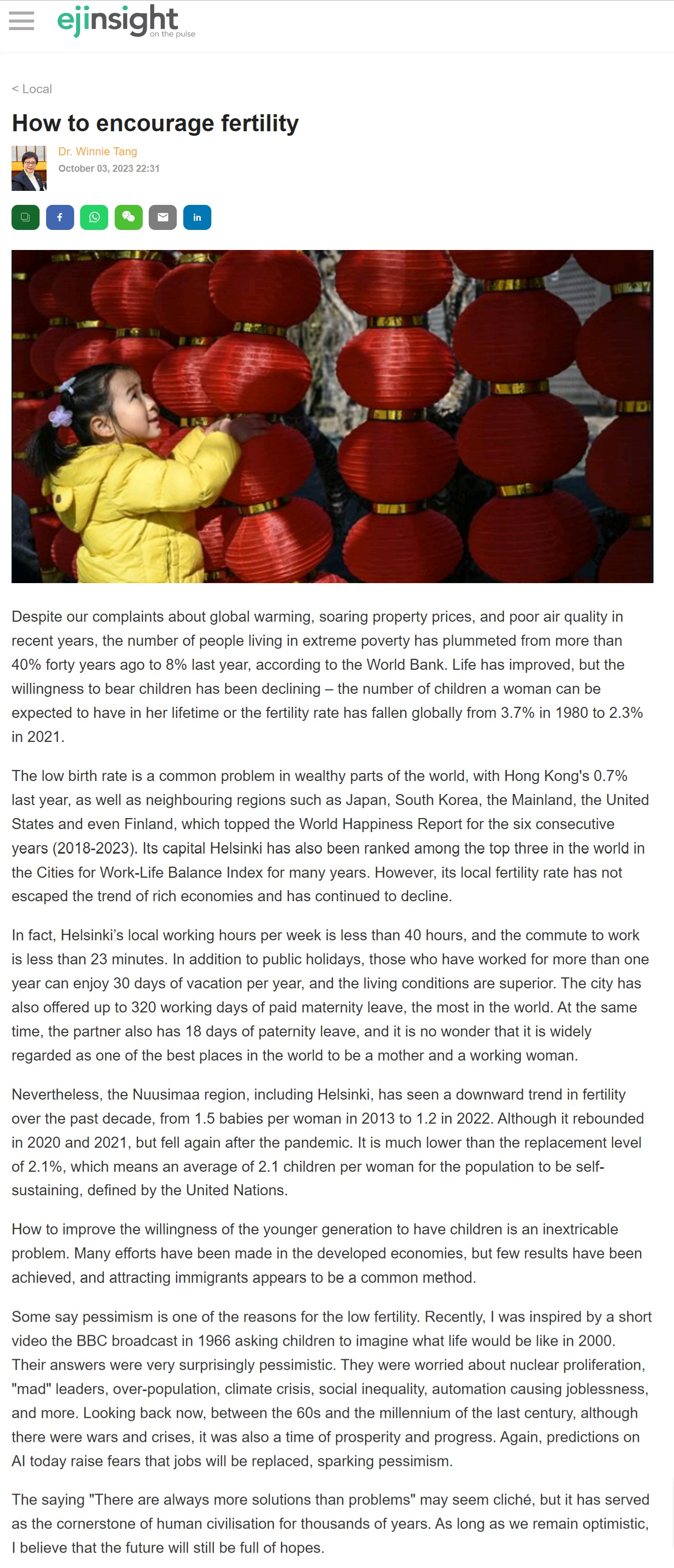網上版請按此

How to encourage fertility
Despite our complaints about global warming, soaring property prices, and poor air quality in recent years, the number of people living in extreme poverty has plummeted from more than 40% forty years ago to 8% last year, according to the World Bank. Life has improved, but the willingness to bear children has been declining – the number of children a woman can be expected to have in her lifetime or the fertility rate has fallen globally from 3.7% in 1980 to 2.3% in 2021.
The low birth rate is a common problem in wealthy parts of the world, with Hong Kong's 0.7% last year, as well as neighbouring regions such as Japan, South Korea, the Mainland, the United States and even Finland, which topped the World Happiness Report for the six consecutive years (2018-2023). Its capital Helsinki has also been ranked among the top three in the world in the Cities for Work-Life Balance Index for many years. However, its local fertility rate has not escaped the trend of rich economies and has continued to decline.
In fact, Helsinki's local working hours per week is less than 40 hours, and the commute to work is less than 23 minutes. In addition to public holidays, those who have worked for more than one year can enjoy 30 days of vacation per year, and the living conditions are superior. The city has also offered up to 320 working days of paid maternity leave, the most in the world. At the same time, the partner also has 18 days of paternity leave, and it is no wonder that it is widely regarded as one of the best places in the world to be a mother and a working woman.
Nevertheless, the Nuusimaa region, including Helsinki, has seen a downward trend in fertility over the past decade, from 1.5 babies per woman in 2013 to 1.2 in 2022. Although it rebounded in 2020 and 2021, but fell again after the pandemic. It is much lower than the replacement level of 2.1%, which means an average of 2.1 children per woman for the population to be self-sustaining, defined by the United Nations.
How to improve the willingness of the younger generation to have children is an inextricable problem. Many efforts have been made in the developed economies, but few results have been achieved, and attracting immigrants appears to be a common method.
Some say pessimism is one of the reasons for the low fertility. Recently, I was inspired by a short video the BBC broadcast in 1966 asking children to imagine what life would be like in 2000. Their answers were very surprisingly pessimistic. They were worried about nuclear proliferation, "mad" leaders, over-population, climate crisis, social inequality, automation causing joblessness, and more. Looking back now, between the 60s and the millennium of the last century, although there were wars and crises, it was also a time of prosperity and progress. Again, predictions on AI today raise fears that jobs will be replaced, sparking pessimism.
The saying "There are always more solutions than problems" may seem cliché, but it has served as the cornerstone of human civilisation for thousands of years. As long as we remain optimistic, I believe that the future will still be full of hopes.
Dr. Winnie Tang
Adjunct Professor, Department of Computer Science, Faculty of Engineering; Department of Geography, Faculty of Social Sciences; and Faculty of Architecture, The University of Hong Kong